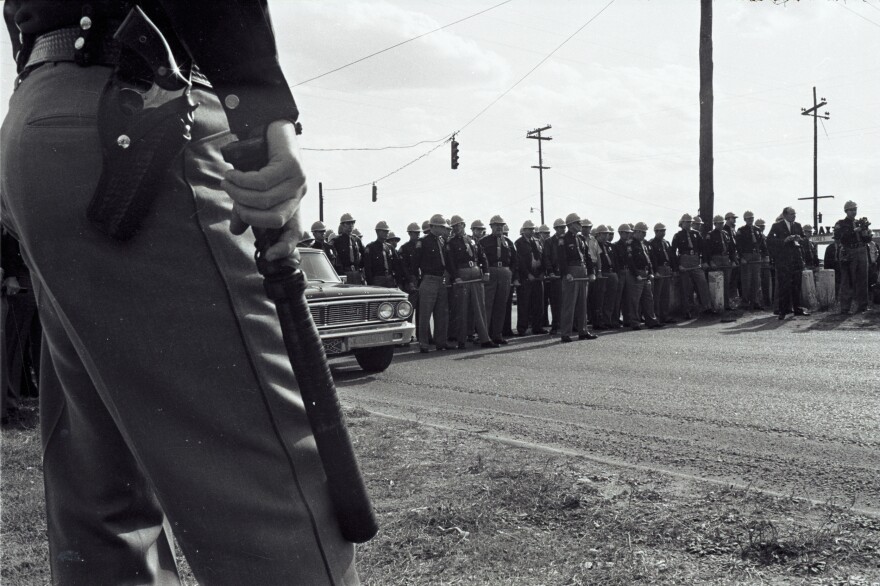Note to our readers: This report contains some strong racial language.
This month Selma, Ala., will mark the 50th anniversary of "Bloody Sunday." That's the day police beat demonstrators attempting to march to Montgomery in support of voting rights. Some of the most iconic images of that day were captured by a white photographer — the late Spider Martin.
Spider Martin's real introduction to the civil rights movement came on a late night at home in February 1965. He was 25, a photographer for The Birmingham News. He explains in a video from 1987 that he got the call because he was the youngest staff member and no one else wanted to go. That assignment would lead to his most famous work.
"About midnight I get this phone call from the chief photographer and he says 'Spider, we need to get you to go down to Marion, Ala.' Says there's been a church burned and there'd been a black man who was protesting killed. He was shot with a shotgun. His name was Jimmie Lee Jackson."
James "Spider" Martin grew up near Birmingham. Small in stature, he earned the nickname "Spider" for his quick moves on the high school football field. He said while he grew up with a few black friends, he was largely ignorant of the injustice blacks faced. That changed once he started covering the Jimmie Lee Jackson case, according to his daughter Tracy.
"He realized that it was history and that it was important," she says. "He got wrapped up in it."

Jackson's killing helped spur the Selma-to-Montgomery voting rights marches a few weeks later. Martin was in Selma for Bloody Sunday when state troopers attacked protesters. Holding a camera made him just as much a target. He recounted in an interview with Alabama Public Television, what happened when a police officer saw him.
"He walks over to me and, blow! Hits me right here in the back of the head," he said. "I still got a dent in my head and I still have nerve damage there. I go down on my knees and I'm like seeing stars and there's tear gas everywhere. And then he grabs me by the shirt and he looks straight in my eyes and he just dropped me and said, 'scuse me. Thought you was a nigger.'"
Martin kept covering the marchers until they reached Montgomery two-and-a-half weeks later.
Martin's collection contains thousands of photographs, clippings and other notes — much of it previously unpublished before it was purchased by the University of Texas. Even producers of the movie Selma used his pictures to recreate scenes for the film. Exhibitions of his work are going up around in Selma for the anniversary, at the Lyndon B. Johnson Presidential Library in Austin, and in New York.

The exhibit at ArtsRevive includes his most noted pictures from the marches. Executive director Martha Lockett says some of her favorites are less recognized including a close-up of an officer's leg with his billy club.
"It's very still, but very energetic," she says. "You know what's getting ready to happen and to me that's one of the most dynamic pictures that's in the show."
That artistry was calculated, according to Morehouse College history professor Larry Spruill. He says Martin was one of a handful of photographers on what's dubbed the "segregation beat." They were mostly college-educated, white men in their 20's who reflected the liberal optimism of a post-World War II generation.

"They took complex issues layered in race and made them very simple," he says.
Spruill says the Rev. Martin Luther King Jr., understood the power of visuals and tipped off photojournalists. And while the optics of Bloody Sunday were credited with shocking middle America — leading to the passage of the 1965 Voting Rights Act — back then the pictures were considered disposable. That was partly because in the mid-'60s, photojournalism was beginning to take a backseat to the flash and immediacy of television. Spruill says he found pictures newspapers didn't run with holes punched through them.
"It's like finding original copies of important American history documents trashed," he says.
A similar thing happened to the photographers. Martin's daughter says it was decades before he became known for his civil rights pictures. He died in 2003 and she says he'd be excited about exhibiting his work around this 50th anniversary. But in his interview it's clear he was uncomfortable with the attention.
"I mean it's kind of fun sometimes being a celebrity, you might say, or a little bit famous. But then again, I'd rather not be famous," he said.
Still the attention he offered through his camera, helped shape American history.
Copyright 2020 WBHM 90.3 FM. To see more, visit WBHM 90.3 FM. 9(MDAwMTM1NDgzMDEyMzg2MDcwMzJjODJiYQ004))


